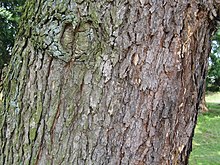Keteleeria
| Keteleeria | ||||||||||||
|---|---|---|---|---|---|---|---|---|---|---|---|---|

Young plant of the common Sichuan fir ( Keteleeria davidiana ) |
||||||||||||
| Systematics | ||||||||||||
|
||||||||||||
| Scientific name | ||||||||||||
| Keteleeria | ||||||||||||
| Carrière |
Keteleeria or Stechtanne is a genus of plants inthe pine family (Pinaceae). It includes three species thatare nativeto Asia .
description
Vegetative characteristics
Keteleeria species are evergreen trees that can reach heights of growth of up to 35 m. The branches are of different lengths. Small, round leaf scars can be seen on the branches.

The leaves are spiral and usually more or less comb-shaped or sometimes almost star-shaped spread out on the branch. The needle-shaped leaves are flat, lanceolate to oblong, 1.5 to 7 cm long and 2 to 4 mm wide. The stomata are usually only arranged in two rows on the underside of the leaf, sometimes there are some on the upper side. There are two resin channels each.
The seedlings have (two to four cotyledons cotyledons ).
Generative characteristics
The Keteleeria species are single sexed ( monoecious ). A special feature of the genera Keteleeria , Pseudolarix and Nothotsuga is that the male cones stand close together in several and develop from one bud. The female cones stand upright at the end, are cylindrical or conical-cylindrical and are 6 to 22 cm long. The female cones need six to eight months from pollination to maturity. The tenons fall off as a whole or the tenon scales detach from the spindle and fall off individually. The shape of the cones and the cone scales is very different in the three types. The cover scales are half to three fifths as long as the seed scales.
The winged seeds are triangular-oblong and 8 to 16 mm in size.
The chromosome number is 2n = 24.
distribution
The occurrences are limited to Asia. The main areal is located in China in the provinces of southern Gansu and southern Shaanxi , eastern Sichuan , Yunnan , southwestern Hubei , Guizhou , Guangxi , Hunan , Guangdong (with Hong Kong and the island of Hainan ), southwestern Jiangxi , Fujian and Zhejiang . There are also occurrences on Taiwan , as well as isolated populations in the mountains of northern Laos and southern Vietnam .
Systematics
The genus Keteleeria was first described in 1866 by Élie-Abel Carrière in Revue Horticole , Volume 37, Page 449. Type species is Keteleeria fortunei (A.Murray bis) Carrière . The genus name Keteleeria honors the Belgian gardener and plant breeder Jean-Baptiste Keteleer (1813–1903). A synonym for Keteleeria Carrière is Abietia A.H. Kent .
The genus includes three types:
- Common Sichuan fir ( Keteleeria davidiana (Bertrand) Beissn. ): Origin : Western China. With two varieties.
- Keteleeria evelyniana mast. : Home: China, Laos, Vietnam
- Hong Kong fir tree ( Keteleeria fortunei (A.Murray bis) Carrière ): Origin : Southeast China
Depending on the author, 3 to 14 types are named. However, most species are often only considered to be varieties of the three species listed above. In the Flora of China, the two species Keteleeria hainanensis Chun & Tsiang and Keteleeria pubescens W.C.Cheng & LKFu are also recorded.
swell
- Genus information at The Gymnosperm Database. (Section systematics)
- Michael P. Frankis: Generic Inter-Relationships in Pinaceae. In: Notes Royal Botanical Garden Edinburgh. 45 (3), 1988, pp. 527-548. online - systematics and precise description with detailed sketches of the plant parts of the genera. (Section systematics and description)
- Pinaceae. In: Flora of China. Volume 4, p. 42: Keteleeria. - online. (Section description)
- Walter Erhardt among others: The big pikeperch. Encyclopedia of Plant Names . Volume 2, Verlag Eugen Ulmer, Stuttgart 2008, ISBN 978-3-8001-5406-7 .
Individual evidence
- ↑ Lotte Burkhardt: Directory of eponymous plant names . Extended Edition. Botanic Garden and Botanical Museum Berlin, Free University Berlin Berlin 2018. [1]
- ↑ Rafaël Govaerts (ed.): Keteleeria. In: World Checklist of Selected Plant Families (WCSP) - The Board of Trustees of the Royal Botanic Gardens, Kew . Retrieved April 10, 2019.

